In a multi-part series, Comic Book Film Editor William Gatevackes will be tracing the history of comic book movies from the earliest days of the film serials to today’s big blockbusters and beyond. Along with the history lesson, Bill will be covering some of the most prominent comic book films over the years and why they were so special. This time, we’ll cover the end of the serial era.
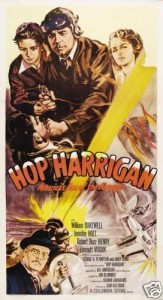 By 1947, the “Golden Age of Serials” was deemed to be at an end. This corresponded with the start of the period where superheroes were growing increasingly out of favor with comic book publishers, being replaced by war, romance, and horror genres.
By 1947, the “Golden Age of Serials” was deemed to be at an end. This corresponded with the start of the period where superheroes were growing increasingly out of favor with comic book publishers, being replaced by war, romance, and horror genres.
Hop Harrigan was an aviator rather than a superhero, but he came into existence way before the fall of the superhero. The character first appeared in 1939 in All-American Comics #1, published by DC/National’s sister company, All-American Publications. The character was adapted into a radio program from 1942 to 1948. In 1946, the character made its way to movies screens in a 15 part Columbia serial of its own, titled, appropriately, Hop Harrigan.
The serial focused on Hop Harrigan facing off against a mad scientist called Dr. Tobor. Much like the comic character himself, the serial faded away into obscurity. No video evidence for the serial can be found.
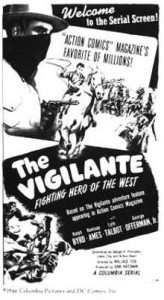 Another DC Comics character hit screens the next year, but not the one you think. It boggles the mind that a rather obscure character such as the Vigilante could have been made into a serial before Superman, but he was. The Vigilante, like Superman, debuted in Action Comics, issue #42 to be exact. Essentially , he was a modern day cowboy whose secret identity was a Gene Autry-esque singing cowboy who wore a disguise to avenge his murdered father.
Another DC Comics character hit screens the next year, but not the one you think. It boggles the mind that a rather obscure character such as the Vigilante could have been made into a serial before Superman, but he was. The Vigilante, like Superman, debuted in Action Comics, issue #42 to be exact. Essentially , he was a modern day cowboy whose secret identity was a Gene Autry-esque singing cowboy who wore a disguise to avenge his murdered father.
The Vigilante serial debuted in 1947 and with a few costume alterations notwithstanding, remained true to the comic. In the Columbia serial, The Vigilante must investigate a case of missing valuable gems smuggled into the country.
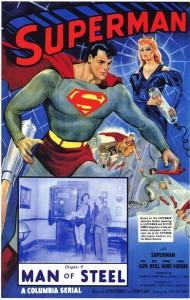 In the next year, Superman finally, at long last, came to movie theaters in a serial of his own. While Republic tried to get the rights to Superman as early as 1940, making a deal for the property was complicated by National/DC insisting on creative control and Superman being licensed to Paramount for a series of animated shorts (for more on the Fleisher cartoons, check out Rich’s write up on them here). This delayed Supes making the plunge into the live action film world.
In the next year, Superman finally, at long last, came to movie theaters in a serial of his own. While Republic tried to get the rights to Superman as early as 1940, making a deal for the property was complicated by National/DC insisting on creative control and Superman being licensed to Paramount for a series of animated shorts (for more on the Fleisher cartoons, check out Rich’s write up on them here). This delayed Supes making the plunge into the live action film world.
By 1948, those rights had expired, allowing Columbia to finally bring one of the most popular comic book heroes to life on the silver screen with Superman. Kirk Alyn was cast as Clark Kent, Noel Neill as Lois Lane, and, in a marketing ploy certainly aimed at the kids in the audience, Columbia stated that there was no actor who could truly do Superman justice, so the Man of Steel played himself (Not to spoil it for anyone who had been holding onto that belief for 53 years, but, in reality, it was Alyn in the costume).
Due to National/DC’s influence, the Superman serial stayed close to the comics. Kirk Alyn made an excellent Superman/Clark Kent and Noel Neill did such a good job as Lois Lane that she would reprise the role on the small screen in The Adventures of Superman.
The serial’s plot involved Superman fighting the machinations of a villainess called The Spider Queen, played by Carol Foreman. The serial was enormously popular, garnering a sequel two years later with the same cast. But before then, there was one other comic book serial released that is worth mentioning.
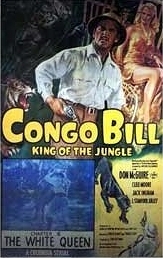 Later in 1948, another National/DC character whose home was in Action Comics hit the world of the film serial. Congo Bill was a serial based on the strip that got its start in 1940 in More Fun Comics before moving over to Action Comics for a lengthy run. Congo Bill was a Caucasian explorer who relocated to the wilds of Africa to keep hius adopted home safe.
Later in 1948, another National/DC character whose home was in Action Comics hit the world of the film serial. Congo Bill was a serial based on the strip that got its start in 1940 in More Fun Comics before moving over to Action Comics for a lengthy run. Congo Bill was a Caucasian explorer who relocated to the wilds of Africa to keep hius adopted home safe.
While Congo Bill getting a serial before other DC mainstays such as Green Arrow or Wonder Woman might make a modern day comic fan start scratching their head, at the time adapting a jungle hero was a no-brainer. Jungle stories were packing them in at the movies at the time, so Columbia must have naturally thought Congo Bill would have been an obvious choice to bring to the screen.
The serial deals with the character searching the African wilderness for a legendary White Priestess.
It’s a shame that the serial didn’t come eleven years later, as DC decided in 1959 to give Congo Bill the ability to swap minds with a golden gorilla named Congorilla. It would have been interesting to see how they would have translated that to the screen.
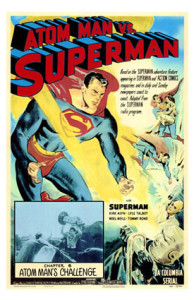 Atom Man vs. Superman arrived in theaters in 1950 and marked the first appearance of Superman’s arch enemy, Lex Luthor, in live action. Luthor was played by Lyle Talbot, who also gained fame by originating the role of Commissioner Gordon in the 1943 Batman serial, and would later become famous (or is that infamous) for his work with legendary shlockmeister Ed Wood, Jr, most notably in Glen or Glenda and Plan 9 From Outer Space. Kirk Alyn returned as Superman/Clark Kent and Noel Neill as Lois Lane.
Atom Man vs. Superman arrived in theaters in 1950 and marked the first appearance of Superman’s arch enemy, Lex Luthor, in live action. Luthor was played by Lyle Talbot, who also gained fame by originating the role of Commissioner Gordon in the 1943 Batman serial, and would later become famous (or is that infamous) for his work with legendary shlockmeister Ed Wood, Jr, most notably in Glen or Glenda and Plan 9 From Outer Space. Kirk Alyn returned as Superman/Clark Kent and Noel Neill as Lois Lane.
In this serial, Superman must fight to keep the world safe from Atom Man (who was really Luthor in disguise) who has developed a “disinegration ray” to hold the world hostage. Atom Man/Luthor also develops a synthetic kryptonite, a plot point that would be revisited over three decades later in Superman III.
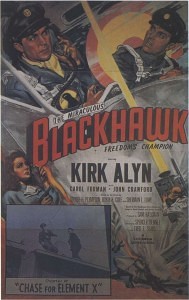 Remember how I told you last time that I would tell you who the Ryan Reynolds and James McAvoy of the serial was? That would be Kirk Alyn, because Alyn, like Reynolds and McAvoy, brought comic book characters from two different companies to life on the silver screen. Reynolds starred as Deadpool in X-Men Origins:Wolverine and Green Lantern in Green Lantern, McAvoy starred as Wesley Gibson from Top Cow’s Wanted and as Marvel’s Professor X in X-Men: First Class, and, as we’ve already said, Kirk Alyn was the first person to play DC’s Superman on screen and, in 1952, he brought Quality Comics’ aviator hero Blackhawk to the screen in his own serial, named Blackhawk.
Remember how I told you last time that I would tell you who the Ryan Reynolds and James McAvoy of the serial was? That would be Kirk Alyn, because Alyn, like Reynolds and McAvoy, brought comic book characters from two different companies to life on the silver screen. Reynolds starred as Deadpool in X-Men Origins:Wolverine and Green Lantern in Green Lantern, McAvoy starred as Wesley Gibson from Top Cow’s Wanted and as Marvel’s Professor X in X-Men: First Class, and, as we’ve already said, Kirk Alyn was the first person to play DC’s Superman on screen and, in 1952, he brought Quality Comics’ aviator hero Blackhawk to the screen in his own serial, named Blackhawk.
Blackhawk and the Blackhawks first appeared in Quality’s Military Comics #1 in 1941. The Blackhawks were an international paramilitary force of flyers brought together by Blackhawk himself to right wrongs and fight evil. The flyers were from areas such as France, Sweden and China and were portrayed in the most stereotypical ways their nationalities could be portrayed.
The Columbia serial toned down the stereotypes and set up the Blackhawks as fighting the Communists. One of the Communist agents was a woman named Laska, portrayed by Carol Foreman. Foreman, as we read above, faced off against Alyn’s Superman as the Spider Queen in the first Superman serial.
Being that this was at the end of the serial’s life cycle, the production values were way down. Not exactly the best way to end the era of the superhero serial.
Interesting tidbit, DC Comics eventually bought out all the Quality characters and concepts in 1956 much like they would the Fawcett characters decades later. Blackhawk was one of the few Quality titles being published at that time, and DC continued publishing the series without a break in numbering.
Next time, we cover the foray comic books made into the world of television, and how one TV show affected the way superheroes were portrayed on the big screen even decades later.



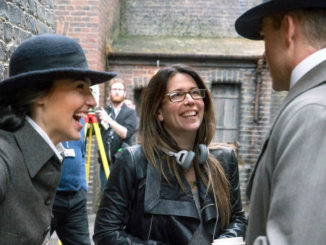

I just thought I’d mention that there was/is one more actor who played more than one superhero. Chris Evans played the Human Torch in the Fantastic Four films, and is currently playing Captain America.